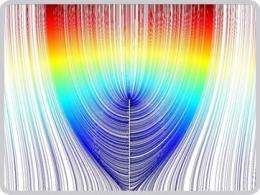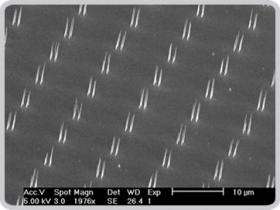The Future Is 3-D Liquid Crystals

(Â鶹ÒùÔºOrg.com) -- Dr. Tim Wilkinson from the Department's Photonics Research Group, University of Cambridge, has made an exciting breakthrough, he has combined liquid crystals with vertically grown carbon nanotubes to create a reconfigurable three-dimensional liquid crystal device structure.
This offers completely new ways to control molecules in liquid crystals, allowing the crystals to move in a variety of directions to create optical components such as lenslet arrays. This technology is still in the early phase of development, but recent trials indicate that potential applications exist in adaptive optical systems such as the wavefront sensors used in optometry, digital video cameras, optical diffusers and emerging head-up display devices.
Liquid crystal (LC) molecules are shaped so that they naturally align with each other if put in a cell to form an optically active pixel. In a display device the liquid crystal pixel is used to change the polarisation of the light passing through it and the degree of change (seen as contrast) is done through an applied voltage onto electrodes at the top and bottom of the cell. The applied voltage makes the LC molecules rotate in the cell and changes their orientation with respect to the light passing through the cell. This cell geometry limits the ways in which the light can interact with the liquid crystal molecules to a 2 dimensional plane. If we add a 3 dimensional element to the lower electrode we can change the way in which the voltage interact with the LC molecules to make a 3 dimensional optical structure. A simple example is shown on the top image on the right handside, where a thin conducting rod is added to the lower electrode to create a Gaussian electric field profile which forms a tiny microlens in the LC material. With many rods it is possible to create array of micro lenses which can have a focal length that varies with the applied voltage. Such a reconfigurable array has many uses in adaptive optical systems and 3D holographic displays.


More importantly this breakthrough changes the way in which we think about creating liquid crystal devices. It allows us to include a 3D element to the design of modulating characteristics. If we address each individual CNT with a separate voltage then we can build more complex 3D refractive index profiles similar to those you would see in a full 3D photographically recorded hologram. However the difference with the LC/CNT device is that the hologram can be changed dynamically as you would change an image on a LCD. This allows full 3D displays to be built using this sort of technology."
Articles on this research appeared in in and in
Provided by University of Cambridge





















